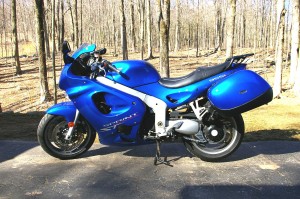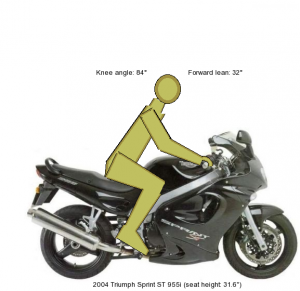By Bud Wilkinson of RIDE-CT.com
Of all the motorcycles that I’ve owned, the worst was probably a blue 2004 Triumph Sprint ST. I bought it based on looks alone – without even taking a test ride. It looked incredibly  sporty on the showroom floor at Canton Cycles and I returned repeatedly to sit on it before pulling the trigger on a deal. While I soon discovered that its 955cc, 118-horsepower, three-cylinder motor had more power than I’d ever use, it handled great and, frankly, enabled me to improve my somewhat nascent riding skills in short order.
sporty on the showroom floor at Canton Cycles and I returned repeatedly to sit on it before pulling the trigger on a deal. While I soon discovered that its 955cc, 118-horsepower, three-cylinder motor had more power than I’d ever use, it handled great and, frankly, enabled me to improve my somewhat nascent riding skills in short order.
The honeymoon was brief, though, due to the riding position. All it took was a one-day, round-trip ride to Americade in Lake George in 2006 for my knees to scream “no mas.” The foot pegs were simply set too far rearward for my knees to tolerate anything other than a short ride. And even the most comfortable seat in the world won’t help if prime body parts – knees, back, shoulders, arms – are in agony.
What made me think of that Triumph this morning was a website called Cycle-Ergo.com.  It has a “Motorcycle Ergonomics Simulator” that allows the rider the enter height and inseam as well as bike brand and model to get a feel for a bike’s suitability. I plugged in my data for the Sprint and found the knee angle is 84 degrees, while the lean angle is 32 degrees. By comparison, my 1994 BMW R100RT has a knee angle of 91 degrees, which is much more upright, and a lean angle of zero degrees, which is dead-on upright.
It has a “Motorcycle Ergonomics Simulator” that allows the rider the enter height and inseam as well as bike brand and model to get a feel for a bike’s suitability. I plugged in my data for the Sprint and found the knee angle is 84 degrees, while the lean angle is 32 degrees. By comparison, my 1994 BMW R100RT has a knee angle of 91 degrees, which is much more upright, and a lean angle of zero degrees, which is dead-on upright.
Having learned the hard way that the Sprint was a bad choice given the decaying condition of my knees, I now have a frame of reference to use in the future when shopping. Cycle-Ergo.com’s simulations also show rider position in relation to the ground – in other words, whether you’ll be tippy-toed or flat-footed on a bike. It’s a neat tool that’s worth checking out.
 Ride CT & Ride New England Serving New England, NYC and The Hudson Valley!
Ride CT & Ride New England Serving New England, NYC and The Hudson Valley!


